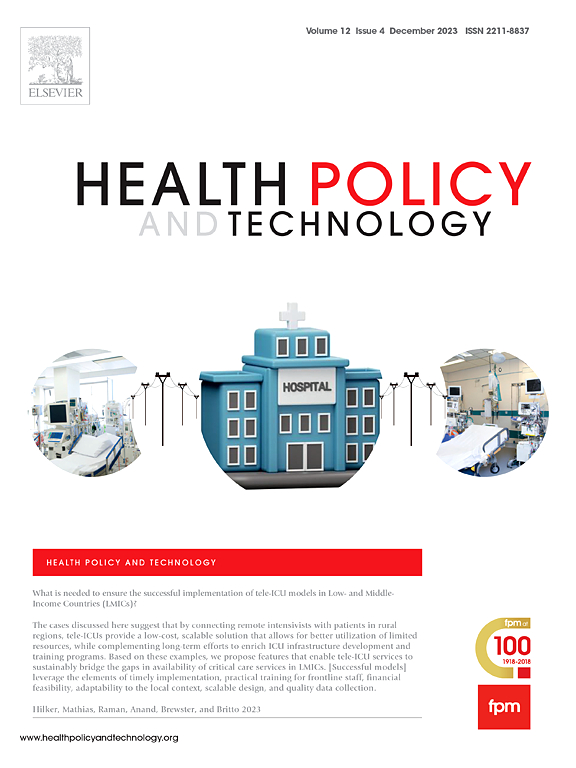Cost effectiveness of esophageal varices screening strategies of cirrhotic patients with portal hypertension
IF 3.4
3区 医学
Q1 HEALTH POLICY & SERVICES
引用次数: 0
Abstract
Objectives
In France, screening for esophageal varices (EVs) in cirrhotic patients with portal hypertension (PH) is performed by esophagogastroduodenoscopy (EGD). Though proven effective, EGD screening may be unpleasant for some patients. Our study sought to compare the cost-effectiveness of PillCam (Medtronic, Minneapolis, USA) esophageal capsule endoscopy (ECE), a less invasive test, versus EGD, for EV screening, from the perspective of the French national health system (NHS). In secondary objectives we compared the cost-effectiveness of ECE versus no screening for patients not compliant with EGD screening, and the cost-effectiveness of a screening strategy (ECE or EGD) versus no screening strategy at all.
Methods
We constructed a Markov model with data from the literature, applying it to two simulated cohorts of adult patients with cirrhosis and PH not previously screened for EVs. These patients were divided into EGD and ECE screening arms and tracked over a virtual 10-year period. Cost-effectiveness was defined as cost (in euros) per quality-adjusted life year (QALY).
Results
In the base-case analysis, ECE is more expensive than EGD (€3,606 vs. €3,030) and less effective by 0.0098 QALY (5.2099 vs. 5.2197 QALYs). Probabilistic sensitivity analysis shows that ECE has only a 2.1 % probability of being cost-effective at willingness-to-pay (WTP) of €30,000/QALY.
Conclusions
Although patient compliance is apparently higher with ECE, it is not cost-effective at a WTP of €30,000/QALY and should not be considered in all patients with PH. Its cost-effectiveness should be reevaluated in the event of patient refusal of EGD follow-up.
Public Interest Summary
Esophagogastroduodenoscopy (EGD) is gold standard to screen cirrhotic patients with portal hypertension for esophageal varices, but its unpleasantness lowers compliance. We evaluated the cost-effectiveness of a more acceptable alternative for patients: the esophageal capsule endoscopy (ECE).
Our results show that screening by ECE is more expensive and less effective than by EGD from the perspective of the French national health system. It cannot be used as an alternative for all patients suffering from PH in France. Further investigations could be conducted to assess the effectiveness of ECE for the sub population of patients with PH who are totally refractory to EGD and may suffer from inadequate follow-up due to lack of screening.
门脉高压肝硬化患者食管静脉曲张筛查策略的成本效益
目的在法国,门静脉高压症(PH)肝硬化患者的食管静脉曲张(EV)筛查是通过食管胃十二指肠镜(EGD)进行的。尽管胃肠镜检查被证明是有效的,但它可能会让一些患者感到不愉快。我们的研究旨在从法国国家医疗系统(NHS)的角度出发,比较 PillCam(美敦力,美国明尼阿波利斯)食管胶囊内窥镜检查(ECE)与 EGD(侵入性较小的检查)在 EV 筛查中的成本效益。在次要目标中,我们比较了对未接受 EGD 筛查的患者进行 ECE 与不进行筛查的成本效益,以及筛查策略(ECE 或 EGD)与不进行筛查的成本效益。这些患者被分为 EGD 和 ECE 筛查两组,并在虚拟的 10 年时间内进行追踪。结果在基础案例分析中,ECE比EGD昂贵(3606欧元对3030欧元),疗效低0.0098 QALY(5.2099 QALYs对5.2197 QALYs)。概率敏感性分析表明,在支付意愿(WTP)为 30000 欧元/QALY 的情况下,ECE 仅有 2.1% 的概率具有成本效益。结论虽然患者对 ECE 的依从性明显较高,但在支付意愿为 30000 欧元/QALY 的情况下,ECE 并不具有成本效益,不应考虑用于所有 PH 患者。公共利益摘要食管胃十二指肠镜检查(EGD)是筛查门脉高压症肝硬化患者食管静脉曲张的金标准,但其不适感降低了患者的依从性。我们对患者更容易接受的替代方法--食管胶囊内镜(ECE)的成本效益进行了评估。我们的结果表明,从法国国家医疗系统的角度来看,ECE筛查比EGD费用更高,效果更差。我们的研究结果表明,从法国国家卫生系统的角度来看,ECE的筛查费用比EGD高,效果却不如EGD,因此不能作为法国所有PH患者的替代检查方法。对于那些对胃肠造影检查完全无效的 PH 患者,由于缺乏筛查而导致随访不足,我们可以开展进一步调查,评估 ECE 对这些患者的有效性。
本文章由计算机程序翻译,如有差异,请以英文原文为准。
求助全文
约1分钟内获得全文
求助全文
来源期刊

Health Policy and Technology
Medicine-Health Policy
CiteScore
9.20
自引率
3.30%
发文量
78
审稿时长
88 days
期刊介绍:
Health Policy and Technology (HPT), is the official journal of the Fellowship of Postgraduate Medicine (FPM), a cross-disciplinary journal, which focuses on past, present and future health policy and the role of technology in clinical and non-clinical national and international health environments.
HPT provides a further excellent way for the FPM to continue to make important national and international contributions to development of policy and practice within medicine and related disciplines. The aim of HPT is to publish relevant, timely and accessible articles and commentaries to support policy-makers, health professionals, health technology providers, patient groups and academia interested in health policy and technology.
Topics covered by HPT will include:
- Health technology, including drug discovery, diagnostics, medicines, devices, therapeutic delivery and eHealth systems
- Cross-national comparisons on health policy using evidence-based approaches
- National studies on health policy to determine the outcomes of technology-driven initiatives
- Cross-border eHealth including health tourism
- The digital divide in mobility, access and affordability of healthcare
- Health technology assessment (HTA) methods and tools for evaluating the effectiveness of clinical and non-clinical health technologies
- Health and eHealth indicators and benchmarks (measure/metrics) for understanding the adoption and diffusion of health technologies
- Health and eHealth models and frameworks to support policy-makers and other stakeholders in decision-making
- Stakeholder engagement with health technologies (clinical and patient/citizen buy-in)
- Regulation and health economics
 求助内容:
求助内容: 应助结果提醒方式:
应助结果提醒方式:


